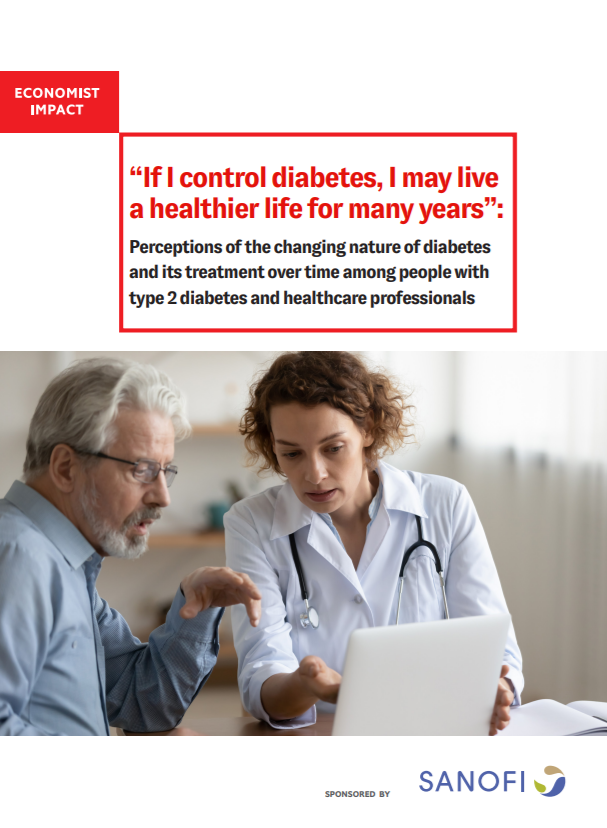Article 2 | Roadmap to resilience: A post pandemic vision of healthcare delivery
Related content

Value-based healthcare in Sweden: Reaching the next level
The need to get better value from healthcare investment has never been more important as ageing populations and increasing numbers of people with multiple chronic conditions force governments to make limited financial resources go further.
These pressures, along with a greater focus on patient-centred care, have raised the profile of VBHC, especially in European healthcare systems. Sweden, with its highly comprehensive and egalitarian healthcare system, has been a leader in implementing VBHC from the beginning, a fact that was underscored in a 2016 global assessment of VBHC published by The Economist Intelligence Unit.
This paper looks at the ways in which Sweden has implemented VBHC, the areas in which it has faced obstacles and the lessons that it can teach other countries and health systems looking to improve the value of their own healthcare investments.

Breast cancer patients and survivors in the Asia-Pacific workforce
With more older women also working, how will the rising trend of breast cancer survivorship manifest in workplace policies, practices and culture? What challenges do breast cancer survivors face when trying to reintegrate into the workforce, or to continue working during treatment? How can governments, companies and society at large play a constructive role?
This series of reports looks at the situation for breast cancer survivors in Australia, New Zealand and South Korea. It finds that while progress has been made, more needs to be done, particularly in South Korea, where public stigma around cancer remains high.
The Cost of Silence
Cardiovascular diseases levy a substantial financial toll on individuals, their households and the public finances. These include the costs of hospital treatment, long-term disease management and recurring incidence of heart attacks and stroke. They also include the costs of functional impairment and knock-on costs as families may lose breadwinners or have to withdraw other family members from the workforce to care for a CVD patient. Governments also lose tax revenue due to early retirement and mortality, and can be forced to reallocate public finances from other budgets to maintain an accessible healthcare system in the face of rising costs.
As such, there is a need for more awareness of the ways in which people should actively work to reduce their CVD risk. There is also a need for more primary and secondary preventative support from health agencies, policymakers and nongovernmental groups.
To inform the decisions and strategies of these stakeholders, The Economist Intelligence Unit and EIU Healthcare, its healthcare subsidiary, have conducted a study of the prevalence and costs of the top four modifiable risk factors that contribute to CVDs across the Asian markets of China, Australia, Hong Kong, Japan, Singapore, South Korea, Taiwan and Thailand.
Download the report to learn more.
Infectious and non-communicable diseases in Asia-Pacific: The need for integrated healthcare
Infectious and non-communicable diseases in Asia-Pacific: The need for integrated healthcare is an Economist Impact report that is sponsored by Roche. The paper analyses the current state of policy and practice regarding infectious and non-communicable diseases in the Asia-Pacific region and advocates ways to better ensure that infectious and non-communicable diseases are tackled synergistically, given their linkages.
Related content

Value-based healthcare in Sweden: Reaching the next level
The need to get better value from healthcare investment has never been more important as ageing populations and increasing numbers of people with multiple chronic conditions force governments to make limited financial resources go further.
These pressures, along with a greater focus on patient-centred care, have raised the profile of VBHC, especially in European healthcare systems. Sweden, with its highly comprehensive and egalitarian healthcare system, has been a leader in implementing VBHC from the beginning, a fact that was underscored in a 2016 global assessment of VBHC published by The Economist Intelligence Unit.
This paper looks at the ways in which Sweden has implemented VBHC, the areas in which it has faced obstacles and the lessons that it can teach other countries and health systems looking to improve the value of their own healthcare investments.

Breast cancer patients and survivors in the Asia-Pacific workforce
With more older women also working, how will the rising trend of breast cancer survivorship manifest in workplace policies, practices and culture? What challenges do breast cancer survivors face when trying to reintegrate into the workforce, or to continue working during treatment? How can governments, companies and society at large play a constructive role?
This series of reports looks at the situation for breast cancer survivors in Australia, New Zealand and South Korea. It finds that while progress has been made, more needs to be done, particularly in South Korea, where public stigma around cancer remains high.
The Cost of Silence
Cardiovascular diseases levy a substantial financial toll on individuals, their households and the public finances. These include the costs of hospital treatment, long-term disease management and recurring incidence of heart attacks and stroke. They also include the costs of functional impairment and knock-on costs as families may lose breadwinners or have to withdraw other family members from the workforce to care for a CVD patient. Governments also lose tax revenue due to early retirement and mortality, and can be forced to reallocate public finances from other budgets to maintain an accessible healthcare system in the face of rising costs.
As such, there is a need for more awareness of the ways in which people should actively work to reduce their CVD risk. There is also a need for more primary and secondary preventative support from health agencies, policymakers and nongovernmental groups.
To inform the decisions and strategies of these stakeholders, The Economist Intelligence Unit and EIU Healthcare, its healthcare subsidiary, have conducted a study of the prevalence and costs of the top four modifiable risk factors that contribute to CVDs across the Asian markets of China, Australia, Hong Kong, Japan, Singapore, South Korea, Taiwan and Thailand.
Download the report to learn more.
Empowering the patient voice in healthcare decisions
Related content

Value-based healthcare in Sweden: Reaching the next level
The need to get better value from healthcare investment has never been more important as ageing populations and increasing numbers of people with multiple chronic conditions force governments to make limited financial resources go further.
These pressures, along with a greater focus on patient-centred care, have raised the profile of VBHC, especially in European healthcare systems. Sweden, with its highly comprehensive and egalitarian healthcare system, has been a leader in implementing VBHC from the beginning, a fact that was underscored in a 2016 global assessment of VBHC published by The Economist Intelligence Unit.
This paper looks at the ways in which Sweden has implemented VBHC, the areas in which it has faced obstacles and the lessons that it can teach other countries and health systems looking to improve the value of their own healthcare investments.

Breast cancer patients and survivors in the Asia-Pacific workforce
With more older women also working, how will the rising trend of breast cancer survivorship manifest in workplace policies, practices and culture? What challenges do breast cancer survivors face when trying to reintegrate into the workforce, or to continue working during treatment? How can governments, companies and society at large play a constructive role?
This series of reports looks at the situation for breast cancer survivors in Australia, New Zealand and South Korea. It finds that while progress has been made, more needs to be done, particularly in South Korea, where public stigma around cancer remains high.
The Cost of Silence
Cardiovascular diseases levy a substantial financial toll on individuals, their households and the public finances. These include the costs of hospital treatment, long-term disease management and recurring incidence of heart attacks and stroke. They also include the costs of functional impairment and knock-on costs as families may lose breadwinners or have to withdraw other family members from the workforce to care for a CVD patient. Governments also lose tax revenue due to early retirement and mortality, and can be forced to reallocate public finances from other budgets to maintain an accessible healthcare system in the face of rising costs.
As such, there is a need for more awareness of the ways in which people should actively work to reduce their CVD risk. There is also a need for more primary and secondary preventative support from health agencies, policymakers and nongovernmental groups.
To inform the decisions and strategies of these stakeholders, The Economist Intelligence Unit and EIU Healthcare, its healthcare subsidiary, have conducted a study of the prevalence and costs of the top four modifiable risk factors that contribute to CVDs across the Asian markets of China, Australia, Hong Kong, Japan, Singapore, South Korea, Taiwan and Thailand.
Download the report to learn more.
Pandemic response: learnings from the World Health Summit keynote session
More from this series
Related content

Value-based healthcare in Sweden: Reaching the next level
The need to get better value from healthcare investment has never been more important as ageing populations and increasing numbers of people with multiple chronic conditions force governments to make limited financial resources go further.
These pressures, along with a greater focus on patient-centred care, have raised the profile of VBHC, especially in European healthcare systems. Sweden, with its highly comprehensive and egalitarian healthcare system, has been a leader in implementing VBHC from the beginning, a fact that was underscored in a 2016 global assessment of VBHC published by The Economist Intelligence Unit.
This paper looks at the ways in which Sweden has implemented VBHC, the areas in which it has faced obstacles and the lessons that it can teach other countries and health systems looking to improve the value of their own healthcare investments.

Breast cancer patients and survivors in the Asia-Pacific workforce
With more older women also working, how will the rising trend of breast cancer survivorship manifest in workplace policies, practices and culture? What challenges do breast cancer survivors face when trying to reintegrate into the workforce, or to continue working during treatment? How can governments, companies and society at large play a constructive role?
This series of reports looks at the situation for breast cancer survivors in Australia, New Zealand and South Korea. It finds that while progress has been made, more needs to be done, particularly in South Korea, where public stigma around cancer remains high.
The Cost of Silence
Cardiovascular diseases levy a substantial financial toll on individuals, their households and the public finances. These include the costs of hospital treatment, long-term disease management and recurring incidence of heart attacks and stroke. They also include the costs of functional impairment and knock-on costs as families may lose breadwinners or have to withdraw other family members from the workforce to care for a CVD patient. Governments also lose tax revenue due to early retirement and mortality, and can be forced to reallocate public finances from other budgets to maintain an accessible healthcare system in the face of rising costs.
As such, there is a need for more awareness of the ways in which people should actively work to reduce their CVD risk. There is also a need for more primary and secondary preventative support from health agencies, policymakers and nongovernmental groups.
To inform the decisions and strategies of these stakeholders, The Economist Intelligence Unit and EIU Healthcare, its healthcare subsidiary, have conducted a study of the prevalence and costs of the top four modifiable risk factors that contribute to CVDs across the Asian markets of China, Australia, Hong Kong, Japan, Singapore, South Korea, Taiwan and Thailand.
Download the report to learn more.
Spotlight on human capital: How health, education and income can drive economic prosperity
Related content

The Hinrich Foundation Sustainable Trade Index 2018
Yet the enthusiasm in Asia for trade does not appear to have waned. This broad societal consensus behind international trade has enabled Asian countries to continue broadening and deepening existing trading relationships, for example, by quickly hammering out a deal for the Comprehensive and Progressive Agreement for Trans-Pacific Partnership (CPTPP) in early 2018 following the US’s withdrawal from its predecessor in 2017.
Asia, then, finds itself in the unique position of helping lead and sustain the global economy’s commitment to free and fair trade. It is in this context that the need for sustainability in trade is ever more crucial.
The Hinrich Foundation Sustainable Trade Index was created for the purpose of stimulating meaningful discussion of the full range of considerations that policymakers, business executives, and civil society leaders must take into account when managing and advancing international trade.
The index was commissioned by the Hinrich Foundation, a non-profit organisation focused on promoting sustainable trade. This, the second edition of the study, seeks to measure the capacity of 20 economies—19 in Asia along with the US—to participate in the international trading system in a manner that supports the long-term domestic and global goals of economic growth, environmental protection, and strengthened social capital. The index’s key findings include:
Countries in Asia, especially the richer ones, have broadly regressed in terms of trade sustainability. Hong Kong is developed Asia’s bright spot, recording a slight increase in its score and topping the 2018 index. Several middle-income countries perform admirably, led by Sri Lanka. For the economic pillar, countries generally performed well in terms of growing their labour forces as well as their per-head GDPs. For the social pillar, sharp drops for some countries in certain social pillar indicators contribute to an overall decline. For the environmental pillar, with deteriorating environmental sustainability in many rich countries, China, Laos and Pakistan are the only countries to record increases in scores. Sustainability is an ever more important determinant of FDI and vendor selection in choosing supply-chain partners. Companies are improving the sustainability of their supply chains by restructuring and broadening relationships with competitors and vendors.
The Global Illicit Trade Environment Index 2018
To measure how nations are addressing the issue of illicit trade, the Transnational Alliance to Combat Illicit Trade (TRACIT) has commissioned The Economist Intelligence Unit to produce the Global Illicit Trade Environment Index, which evaluates 84 economies around the world on their structural capability to protect against illicit trade. The global index expands upon an Asia-specific version originally created by The Economist Intelligence Unit in 2016 to score 17 economies in Asia.
View the Interactive Index >> Download workbook

Breaking Barriers: Agricultural trade between GCC and Latin America
The GCC-LAC agricultural trading relationship has thus far been dominated by the GCC’s reliance on food imports, specifically meat, sugar, and cereals. Over the past two years, however, there has been a notable decline in the share of sugar imported from LAC, and 2017 saw the biggest importers in the GCC—Saudi Arabia and the UAE—impose a ban on Brazilian meat.
Market players on both sides of the aisle are keen to grow the relationship further, but there are hurdles to overcome. In this report, we explore in greater depth the challenges that agricultural exporters and importers in LAC and the GCC face. We consider both tariff and non-tariff barriers and assess key facets of the trading relationship including transport links, customs and certification, market information, and trade finance.
Key findings of the report:
GCC will need to continue to build partnerships to ensure a secure supply of food. Concerns over food security have meant that the GCC countries are exploring ways to produce more food locally. However, given the region’s climate and geology, food imports will remain an important component of the food supply. Strengthening partnerships with key partners such as those in LAC, from which it sourced 9% of its total agricultural imports in 2016, will be vital to food security in the region.
There is a wider range of products that the LAC countries can offer the GCC beyond meat, sugar and cereals. Providing more direct air links and driving efficiencies in shipping can reduce the time and cost of transporting food products. This will, in turn, create opportunities for LAC exporters to supply agricultural goods with a shorter shelf life or those that are currently too expensive to transport. Exporters cite examples such as berries and avocados.
The GCC can engage small and medium-sized producers that dominate the LAC agricultural sector by offering better trade financing options and connectivity. More direct air and sea links can reduce the cost of transporting food products, making it viable for smaller players to participate in agricultural trade. The existing trade financing options make it prohibitive for small and medium-sized players too. Exporters in LAC suggest that local governments and private companies in the GCC can offer distribution services with immediate payments to smaller suppliers at a discount.
Blockchain technology is poised to address key challenges market players face in agricultural trade. Through a combination of smart contracts and data captured through devices, blockchain technology can help to reduce paperwork, processing times and human error in import and export processes. It can improve transparency, as stakeholders can receive information on the state of goods and status of shipments in real time. Finally, it can help with food safety and quality management—monitoring humidity and temperature, for instance, along the supply chain can help to pinpoint batches that may be contaminated, minimising the need for a blanket ban on a product.
Perceptions of the changing nature of diabetes and its treatment over time among people with type 2 diabetes and healthcare professionals
Related content

Value-based healthcare in Sweden: Reaching the next level
The need to get better value from healthcare investment has never been more important as ageing populations and increasing numbers of people with multiple chronic conditions force governments to make limited financial resources go further.
These pressures, along with a greater focus on patient-centred care, have raised the profile of VBHC, especially in European healthcare systems. Sweden, with its highly comprehensive and egalitarian healthcare system, has been a leader in implementing VBHC from the beginning, a fact that was underscored in a 2016 global assessment of VBHC published by The Economist Intelligence Unit.
This paper looks at the ways in which Sweden has implemented VBHC, the areas in which it has faced obstacles and the lessons that it can teach other countries and health systems looking to improve the value of their own healthcare investments.

Breast cancer patients and survivors in the Asia-Pacific workforce
With more older women also working, how will the rising trend of breast cancer survivorship manifest in workplace policies, practices and culture? What challenges do breast cancer survivors face when trying to reintegrate into the workforce, or to continue working during treatment? How can governments, companies and society at large play a constructive role?
This series of reports looks at the situation for breast cancer survivors in Australia, New Zealand and South Korea. It finds that while progress has been made, more needs to be done, particularly in South Korea, where public stigma around cancer remains high.How to secure the future funding and sustainability of UK care homes
Related content

Value-based healthcare in Sweden: Reaching the next level
The need to get better value from healthcare investment has never been more important as ageing populations and increasing numbers of people with multiple chronic conditions force governments to make limited financial resources go further.
These pressures, along with a greater focus on patient-centred care, have raised the profile of VBHC, especially in European healthcare systems. Sweden, with its highly comprehensive and egalitarian healthcare system, has been a leader in implementing VBHC from the beginning, a fact that was underscored in a 2016 global assessment of VBHC published by The Economist Intelligence Unit.
This paper looks at the ways in which Sweden has implemented VBHC, the areas in which it has faced obstacles and the lessons that it can teach other countries and health systems looking to improve the value of their own healthcare investments.

Breast cancer patients and survivors in the Asia-Pacific workforce
With more older women also working, how will the rising trend of breast cancer survivorship manifest in workplace policies, practices and culture? What challenges do breast cancer survivors face when trying to reintegrate into the workforce, or to continue working during treatment? How can governments, companies and society at large play a constructive role?
This series of reports looks at the situation for breast cancer survivors in Australia, New Zealand and South Korea. It finds that while progress has been made, more needs to be done, particularly in South Korea, where public stigma around cancer remains high.
The Cost of Silence
Cardiovascular diseases levy a substantial financial toll on individuals, their households and the public finances. These include the costs of hospital treatment, long-term disease management and recurring incidence of heart attacks and stroke. They also include the costs of functional impairment and knock-on costs as families may lose breadwinners or have to withdraw other family members from the workforce to care for a CVD patient. Governments also lose tax revenue due to early retirement and mortality, and can be forced to reallocate public finances from other budgets to maintain an accessible healthcare system in the face of rising costs.
As such, there is a need for more awareness of the ways in which people should actively work to reduce their CVD risk. There is also a need for more primary and secondary preventative support from health agencies, policymakers and nongovernmental groups.
To inform the decisions and strategies of these stakeholders, The Economist Intelligence Unit and EIU Healthcare, its healthcare subsidiary, have conducted a study of the prevalence and costs of the top four modifiable risk factors that contribute to CVDs across the Asian markets of China, Australia, Hong Kong, Japan, Singapore, South Korea, Taiwan and Thailand.
Download the report to learn more.
Projet global de financement pour l’élimination du cancer du col de l’utérus : Financer la prévention secondaire dans les contextes de faible revenu
Related content

Medidas globales de financiación para eliminar el cáncer de cuello uterino:...
El cáncer de cuello uterino es el cuarto cáncer que se detecta con mayor frecuencia en mujeres en todo el mundo, aunque es uno de los tipos de cáncer que mejor se pueden tratar y más se pueden prevenir si se detectan a tiempo. La morbilidad y la mortalidad del cáncer de cuello uterino afectan de forma dispar a las mujeres de países con unos ingresos bajos o entre bajos y medios, y aquellas de los países más pobres. En 2020, la Organización Mundial de la Salud (OMS) introdujo una iniciativa global para erradicar el cáncer de cuello uterino como problema de salud pública, y estableció objetivos intermedios para 2030.
Aunque existen dificultades en países con bajos recursos en torno a la viabilidad a largo plazo y la sostenibilidad económica de las iniciativas para abordar esta prioridad urgente de salud, la idea de conseguir una erradicación representa una nueva oportunidad de adoptar un enfoque de continuidad, en el que se toma como base la cobertura sanitaria universal y se exploran enfoques innovadores en cuanto a la financiación y la prestación a medida que los países amplían sus servicios de erradicación.
En este informe de The Economist Intelligence Unit se exploran algunos de desafíos de alto nivel asociados a la financiación de la erradicación del cáncer de cuello uterino en países con recursos limitados. Se aprovechar el conjunto de prioridades que se presenta a continuación para involucrar a los responsables de la toma de decisiones de financiación y políticas:
Generar información local para la toma de decisiones y el planteamiento de una financiación sanitaria. Se requiere un análisis en profundidad de la epidemiología, así como de los obstáculos para la detección del cáncer de cuello uterino y, cuando sea necesario, de los servicios de tratamiento de seguimiento en el ámbito del país, así como fundamentar la priorización de las soluciones más sostenibles y con el mayor impacto. Asimismo, dichos análisis deben identificar y abordar las deficiencias en materia de financiación y asignación de recursos dentro de los sistemas sanitarios.
Evaluar la financiación nacional y el alcance de los servicios de gran calidad mediante el uso de las herramientas disponibles de cálculo de costes y elaboración de modelos de la OMS para elaborar planes de ampliación graduales y viables. Las soluciones diseñadas para ajustarse a las limitaciones de asequibilidad y capacidad de cada país resultarán más sostenibles a largo plazo. Se debe dar prioridad al uso de las herramientas existentes de cálculo de costes y elaboración de modelos para identificar carencias y oportunidades para pasar gradualmente a programas de ámbito nacional. El éxito de los programas de erradicación depende de un enfoque sistemático y organizado, que se implementa a través del marco de una cobertura sanitaria universal bien planificada con presupuestos y planes de servicios sanitarios integrados.
Abogar por la integración en el ámbito de las políticas, la financiación, los programas y los servicios para alcanzar el éxito y la sostenibilidad. A la hora de abordar la sanidad pública, los enfoques independientes introducen deficiencias desde el punto de vista financiero que se deben evitar. Se debería obtener partido del solapamiento entre el cáncer de cuello uterino y otras prioridades de la sanidad pública —como el VIH y los servicios sanitarios de reproducción—, y aprovechar el marco de la estrategia de erradicación a nivel mundial de la OMS para generar una integración financiera. Se requiere un sólido liderazgo en el ámbitos nacional y de prestación de servicios para garantizar la integración y que se materialicen los beneficios asociados.
Utilizar soluciones financieras innovadoras y mixtas para complementar la financiación nacional. La financiación nacional de los servicios oncológicos —incluidos los del cáncer de cuello uterino— en países con bajos recursos es posible que no sea suficiente para ampliar los programas nacionales. Las consecuencias económicas globales de la pandemia de la COVID-19 afectarán aún más a los presupuestos sanitarios. Los países deben ampliar sus inversiones nacionales y hacer un mejor uso de los impuestos y los programas de seguros sociales, al tiempo que se aprovechan los sistemas de financiación suplementaria alternativos donde proceda. Debería plantearse un enfoque colaborativo por el que se aprovechen los bancos de desarrollo, la financiación mixta, el capital, la experiencia y la celeridad del sector privado.

Value-based healthcare in Sweden: Reaching the next level
The need to get better value from healthcare investment has never been more important as ageing populations and increasing numbers of people with multiple chronic conditions force governments to make limited financial resources go further.
These pressures, along with a greater focus on patient-centred care, have raised the profile of VBHC, especially in European healthcare systems. Sweden, with its highly comprehensive and egalitarian healthcare system, has been a leader in implementing VBHC from the beginning, a fact that was underscored in a 2016 global assessment of VBHC published by The Economist Intelligence Unit.
This paper looks at the ways in which Sweden has implemented VBHC, the areas in which it has faced obstacles and the lessons that it can teach other countries and health systems looking to improve the value of their own healthcare investments.

Breast cancer patients and survivors in the Asia-Pacific workforce
With more older women also working, how will the rising trend of breast cancer survivorship manifest in workplace policies, practices and culture? What challenges do breast cancer survivors face when trying to reintegrate into the workforce, or to continue working during treatment? How can governments, companies and society at large play a constructive role?
This series of reports looks at the situation for breast cancer survivors in Australia, New Zealand and South Korea. It finds that while progress has been made, more needs to be done, particularly in South Korea, where public stigma around cancer remains high.Medidas globales de financiación para eliminar el cáncer de cuello uterino: financiación de servicios de prevención secundaria en países con bajos recursos
El cáncer de cuello uterino es el cuarto cáncer que se detecta con mayor frecuencia en mujeres en todo el mundo, aunque es uno de los tipos de cáncer que mejor se pueden tratar y más se pueden prevenir si se detectan a tiempo. La morbilidad y la mortalidad del cáncer de cuello uterino afectan de forma dispar a las mujeres de países con unos ingresos bajos o entre bajos y medios, y aquellas de los países más pobres. En 2020, la Organización Mundial de la Salud
Related content

Projet global de financement pour l’élimination du cancer du col de l’utéru...
Le cancer du col de l’utérus est le quatrième cancer le plus courant chez les femmes à travers le monde. Pourtant, il s’agit de l’un des cancers les plus faciles à prévenir et à traiter en cas de détection précoce. Les femmes vivant dans les pays à revenu faible ou intermédiaire et les femmes les plus défavorisées au sein de tous les pays ont beaucoup plus de probabilités de développer un cancer du col de l’utérus et d’en mourir. En 2020, l’Organisation Mondiale de la Santé (OMS) a lancé une initiative mondiale visant à éliminer le cancer du col de l’utérus en tant que problème de santé publique, avec des objectifs intermédiaires à atteindre d’ici 2030.
Alors qu’il existe des défis dans les contextes de faible revenu au regard de la viabilité et la pérennité des financements des efforts liés à cette priorité de santé publique, l’ambition d’élimination représente une nouvelle opportunité d’adopter une approche globale. Il s’agira dès lors de s’appuyer sur la couverture de santé universelle et d’envisager des modes de financement et d’interventions innovants pour développer progressivement les services d’élimination de la maladie dans chaque pays.
Ce rapport de The Economist Intelligence Unit aborde les principaux défis liés au financement pour l’élimination du cancer du col de l’utérus dans des contextes de faible revenu. Les priorités listées ci-dessous peuvent servir à interpeller les dirigeants politiques ou les organismes de financement :
Recueillir des données locales pour mieux documenter la conception et les prises de décisions concernant les mécanismes de financement en santé. Dans chaque pays, il est indispensable de disposer d’une connaissance approfondie de l’épidémiologie et des freins qui pourraient s’opposer au déploiement du dépistage du cancer du col de l’utérus et, si nécessaire, à l’accès aux traitements, afin de donner la priorité aux solutions les plus efficaces et les plus durables. Ces analyses doivent aussi permettre d’identifier et de résoudre les problèmes de financement et de distribution des ressources au sein des systèmes de santé.
Déterminer les capacités de financement au niveau national dans chaque pays et la disponibilité de services de qualité à l’aide d’outils existants d’évaluation et de projection des coûts pour concevoir des programmes d’élimination adaptés et réalistes. À ce titre, des solutions adaptées aux possibilités et aux ressources de chaque pays seront plus pérennes. Les outils actuels d’évaluation et de projection des coûts doivent être utilisés en priorité pour identifier les opportunités et les insuffisances afin de pouvoir étendre progressivement les programmes d’élimination au niveau national. Leur bon fonctionnement repose sur une approche systématique et organisée, qui sera plus facile à déployer dans le cadre d’une couverture sanitaire universelle efficace, intégrant la budgétisation et la planification des services de santé.
Favoriser l’intégration de cet objectif aux enjeux politiques, au financement, à un programme et aux services de santé pour une efficacité durable. Les approches cloisonnées de la santé publique créent des inefficacités pouvant être minimisées ou complètement évitées. Les synergies avec d’autres priorités de santé publique, comme le VIH ou la planification familiale, doivent être recherchées. Le cadre de la stratégie mondiale de l’OMS pour l’élimination doit être utilisé pour promouvoir l’intégration financière. Un engagement fort des preneurs de décision aux niveaux mondial, national, programmatique et des services doit être encouragé pour s’assurer que l’intégration soit optimale et que tous les bénéfices en soient tirés.
Privilégier des solutions innovantes optimisant différentes sources de financement pour compléter le financement national.Dans des contextes de faible revenu, le financement national dédié aux services de lutte contre le cancer, dont le cancer du col de l’utérus, n’est pas suffisant pour développer des programmes à l’échelle nationale. Les conséquences financières mondiales de la pandémie de Covid-19 impacteront à long terme le financement de la santé. Les pays concernés doivent accroître leurs dépenses nationales de santé et améliorer leur utilisation des impôts et des systèmes d’assurance maladie, tout en favorisant l’utilisation d’autres systèmes de financement alternatifs lorsqu’ils sont disponibles. Des approches en consortium permettant de mobiliser des fonds auprès de banques de développement en combinant financement public et privé tout en favorisant l’expertise et la rapidité doit être envisagé.

Value-based healthcare in Sweden: Reaching the next level
The need to get better value from healthcare investment has never been more important as ageing populations and increasing numbers of people with multiple chronic conditions force governments to make limited financial resources go further.
These pressures, along with a greater focus on patient-centred care, have raised the profile of VBHC, especially in European healthcare systems. Sweden, with its highly comprehensive and egalitarian healthcare system, has been a leader in implementing VBHC from the beginning, a fact that was underscored in a 2016 global assessment of VBHC published by The Economist Intelligence Unit.
This paper looks at the ways in which Sweden has implemented VBHC, the areas in which it has faced obstacles and the lessons that it can teach other countries and health systems looking to improve the value of their own healthcare investments.

Breast cancer patients and survivors in the Asia-Pacific workforce
With more older women also working, how will the rising trend of breast cancer survivorship manifest in workplace policies, practices and culture? What challenges do breast cancer survivors face when trying to reintegrate into the workforce, or to continue working during treatment? How can governments, companies and society at large play a constructive role?
This series of reports looks at the situation for breast cancer survivors in Australia, New Zealand and South Korea. It finds that while progress has been made, more needs to be done, particularly in South Korea, where public stigma around cancer remains high.The impact of covid-19 on non-communicable diseases in Asia
The covid-19 pandemic, which assumed global proportions in the first half of 2020, has drastically impacted how healthcare systems operate. While much attention has necessarily focussed on the medical response to the pandemic, the broader impact on other aspects of health services such as the provision of care for non-communicable diseases (NCDs), like cancer, heart disease, diabetes, is more difficult to quantify. One NCD which has had a particularly low public profile during this period is osteoporosis.
More from this series
17623
Related content

Osteoporosis: A challenge obscured, not eliminated
Covid-19 has rightly seized the attention of health system officials. Nevertheless, the disease has done nothing to change the underlying consideration which led the WHO – and, just as recently, also the Asia-Pacific Economic Cooperation (APEC) and the G201 – to raise the policy profile of healthy ageing’s importance to economic growth and human well-being. More and more of us are living longer and longer. This is good news, but also presents challenges. One too often overlooked will be the need to address a rapid increase in the proportion of people susceptible to osteoporosis and its attendant, often devastating, bone fractures.
Ageing populations: Asia-Pacific in the lead
This demographic shift is most visible in Asia, with its unprecedentedly rapid population ageing. In the first half of the 21st century, the proportion of people aged 60 or more in many leading Asia-Pacific countries, and in the region as a whole, will roughly triple – in some cases quadruple. The partial exceptions, such as Japan and Australia, are countries where population ageing began earlier (Figure 1).
Such percentage figures in part reflect the region’s very low, by historic standards, birth rates. Also at play, though, is increasing longevity. Currently, of the jurisdictions covered by UN Population Division data, four of the five with the highest life expectancy are in Asia – Hong Kong, Japan, Macao, and Singapore – while Australia and South Korea also make the top 11. Newborns in all these places can expect to live 84 or 85 years.2
This growing longevity, along with limited but still positive population growth in much of Asia, is driving a rapid increase in the absolute numbers of older individuals across the region. In most major countries, the number of people aged 60 and above will, during the Decade of Healthy Ageing alone, rise by between roughly a third and a half. After that 10-year span, 250 million more over 60s will live in Asia-Pacific than when the decade started – 41% growth (Table 1).
Rapidly expanding osteoporosis risk
This rising longevity represents a societal and medical triumph. It also, though, brings substantial healthcare challenges. Age correlates with any number of noncommunicable disease (NCDs) such as diabetes, cancer, and cardiovascular diseases. These already represent a formidable burden on health systems and a challenge to governments seeking to provide sustainable health services. Nevertheless, their human and economic cost can be greatly reduced by primary and secondary prevention, early diagnosis, and effective treatment. Delivering these interventions for NCDs as a whole, though, remains very much a “work in progress” for most health systems. “We’re right at the point of inflection,” says Paul Mitchell, communications director and executive board member of the Fragility Fracture Network. “We’re entering a new demographic era. If we don’t radically change the way that we respond to the longevity miracle by putting into place systems that optimise recovery, prevent events and enable older people to lead independent lives as long as possible, then the human and economic costs will be dire.”
Osteoporosis provides one of the clearest examples of a challenge which health systems already need to address and which will become only more pressing with as Asia-Pacific’s population of older citizens burgeons. Some time around the age of 25 to 30, the typical person begins to experience a loss in bone mineral density (BMD). This continues to some extent throughout one’s life and accelerates in women during the years of menopause. Although some decline in BMD is natural, it can go too far. Put simply, osteoporosis is the term for when this process reduces BMD to a dangerously low level.
The link between ageing and osteoporosis prevalence is both clear and dramatic. South Korean national survey figures show that 15% of women in that country have the condition while in their 50s, but this proportion rises steadily over time so that 86% of those in their 80s. The equivalent figures for men, 4% and 27%, are less dramatic but still indicate a widespread health issue.3 Although comparable prevalence data from other countries are limited, South Korea’s figures are consistent with those found elsewhere. A study of a rural population in Henan, China, also saw a steady increase in the number affected from age 50 onward and had similar results to the Korean one for people in their 70s (female prevalence was 37% in both; male was 20% in Henan and 15% in Korea).4 An urban Indian study, meanwhile, found that, among its subjects average, BMD started below that of the Korean average for people in their 40s and then declined even more rapidly over time.5
From Osteoporosis to the Toll of Fragility Fracture
Osteoporosis does not diminish quality of life: many who have it fail even to notice. The clinical problem is the greatly heightened risk off fragility fractures – the term for breaks caused by events or injuries which would not under normal circumstances be expected to cause a fracture. These typically occur at the wrist, spine, and hip. All can be serious and represent health system challenges. For example, although many fragility fractures of the spine may initially be small, treatment of serious ones cost the South Korean National Health Insurance Service US$282m in 2016 – an increase of 46% from just four years earlier.6
That said, fragility fractures of the hip are generally the most serious ones and associated with the greatest healthcare burden. A study covering nine major Asian jurisdictions, which collectively have 70% of the continent’s population – China, Hong Kong, India, Japan, South Korea, Malaysia, Singapore, Taiwan, and Thailand – estimated that in 2018 these places 1.12m hip fractures.7
The resultant human and economic costs implications are likely stark. One-year mortality after a hip fracture in Asia – in both middle and high-income states – range between around 10% and around 25%, reaching 30% in India. This is consistent with outcomes in much of the rest of the world.8 Meanwhile those who do survive continue to face significant challenges. An extensive research review found that typically only around half regain their previous physical capacity.9 The economic cost is also substantial. The nine-nation study cited above calculated that the aggregate direct treatment costs in those countries reached US$9.5 bn in 2018.10
This same research provides worrying projections for the future: if nothing is done, demographic change alone will mean that by 2050 the nine countries it covers will see 2.56m hip fractures which health systems will need to spend US$15bn to treat, not accounting for any inflation.11
Finally, not all hip-fracture patients receive the necessary surgery due to the lack of access to affordable services in resource-limited or rural settings. Even where appropriate treatment is accessible and government-funded, costs for rehabilitation and prevention of second fractures are a burden. In Taiwan, for example, lower socio-economic status was related to an increased risk of death in the one year following a hip fracture.12
Now That We Have Your Attention…
Demographics are not destiny. Asia does not need to face what Dr Irewin Tabu, – a leading orthopaedist in the Philippines – calls the “tsunami of fragility fractures” that would go with rising osteoporosis prevalence. Potential interventions exist to prevent osteoporosis and its results: in individuals both young and old, appropriate lifestyle choices – including eating healthy foods, engaging in weight-bearing exercise, and not smoking – can help maintain BMD, thereby reducing the chances of developing osteoporosis; various medications can increase BMD, thereby decreasing the chance of fracture when osteoporosis is diagnosed; effective rehabilitation and secondary prevention after fractures can reduce the likelihood for further breakages (which are often worse than the initial ones).
With so many people affected by osteoporosis, any universal or universalising health system will need to take it seriously. In order to help stakeholders understand the scope of the challenge and possible options available to address it, the Economist Intelligence Unit, sponsored by Amgen, has published two important studies: Demystifying ageing: Lifting the burden of fragility fractures and osteoporosis in Asia-Pacific (2017)13 and Ageing with strength: Addressing fragility fractures in Asia-Pacific (2019).14 We are now building on this with the current article as well as a series of newsletters in the coming months to look at several of the most prominent issues in the area of osteoporosis and fragility fracture care. Future topics will include: the impact of Covid-19 on osteoporosis diagnosis, monitoring, and treatment; the state of care the Philippines and Thailand, two important Asian emerging economies; and innovations in policy advocacy and stakeholder cooperation to address this complex challenge. Please keep an eye out for these publications.
1. Asia-Pacific Economic Cooperation, https://www.apec.org/Groups/SOM-Steering-Committee-on-Economic-and-Techn... ; G20, https://g20-meeting2019.mhlw.go.jp/health/img/G20Okayama_HM_EN.pdf 2. United Nations, Department of Economic and Social Affairs, Population Division, World Population Prospects 2019, 2019, online database, https://population.un.org/wpp/ 3. Jongseok Lee et al., “Age-Related Changes in the Prevalence of Osteoporosis according to Gender and Skeletal Site: The Korea National Health and Nutrition Examination Survey 2008-2010,” Endocrinology and Metabolism, 2013, https://www.ncbi.nlm.nih.gov/pmc/articles/PMC3811701/ 4. Dou Qiao et al., “Gender-specific prevalence and influencing factors of osteopenia and osteoporosis in Chinese rural population: the Henan Rural Cohort Study,” BMJ Open, 2020, https://bmjopen.bmj.com/content/bmjopen/10/1/e028593.full.pdf 5. A Ramalingaiah et al., “Burden of Osteoporosis in the Urban Indian Population,” EC Orthopaedics 2017, https://www.ecronicon.com/ecor/pdf/ECOR-07-00196.pdf 6. Sung Hoon Choi et al., “Incidence and Management Trends of Osteoporotic Vertebral Compression Fractures in South Korea: A Nationwide Population-Based Study,” Asian Spine Journal, 2020, https://www.asianspinejournal.org/journal/view.php?number=1122 7. CL Cheung et al., “An updated hip fracture projection in Asia: The Asian Federation of Osteoporosis Societies study”, Osteoporosis Sarcopenia, Vol. 4, No. 1, 2018, 2018, https://www.ncbi.nlm.nih.gov/pubmed/30775536 8. Colum Downey et al., “Changing trends in the mortality rate at 1-year post hip fracture – a systematic review,” World Journal of Orthopedics¸ 2019, https://www.ncbi.nlm.nih.gov/pmc/articles/PMC6428998/. NB: The Japanese figure of 2.4% in this article should be discounted. Examination of the source shows that this was the outcome of the intervention arm of a small trial and not representative of normal care (TomohiroYoshizawa et al., “Rehabilitation in a convalescent rehabilitation ward following an acute ward improves functional recovery and mortality for hip fracture patients: a sequence in a single hospital,” Journal of Physical Therapy Science, 2017, https://www.jstage.jst.go.jp/article/jpts/29/6/29_jpts-2017-131/_pdf/-ch... 9. Suzanne Dyer, “A critical review of the long-term disability outcomes following hip fracture,” BMC Geriatrics, 2016, https://bmcgeriatr.biomedcentral.com/articles/10.1186/s12877-016-0332-0 10. CL Cheung et al., “An updated hip fracture projection in Asia: The Asian Federation of Osteoporosis Societies study”, Osteoporosis Sarcopenia, Vol. 4, No. 1, 2018, 2018, https://www.ncbi.nlm.nih.gov/pubmed/30775536 11. Ibid. 12. Hsu I-Lin, et al. “Socioeconomic Inequality in One-Year Mortality of Elderly People with Hip Fracture in Taiwan”, International Journal of Environmental Research and Public Health, 2018, https://www.mdpi.com/1660-4601/15/2/352 13. https://eiuperspectives.economist.com/healthcare/demystifying-ageing-lif... 14. https://eiuperspectives.economist.com/healthcare/ageing-strength-address...
Demystifying ageing: Lifting the burden of fragility fractures and osteopor...
Fragility fractures are already a significant public health challenge across Asia-Pacific. Their lasting impact on societies and economies is well-documented, leading to loss of mobility, independence and, in some instances, death for their elderly sufferers. In many traditional Asia-Pacific societies, where older people often serve as caregivers for younger generations, fractures can devastate entire families and communities. From a broader perspective, the cost of treating hip fractures to Asia-Pacific societies equates to 19% of GDP per capita, underscoring the enormity of the problem.
As populations age, many believe fragility fractures will become more widespread, yet this is not necessarily the case. Osteoporosis, a condition that makes bones more likely to break and a leading cause of fractures, was within living memory thought to be a natural part of ageing. This myth is gradually being dispelled. The condition is preventable and treatable—a fact which receives too little attention across the region. This study looks at the challenge fragility fractures and osteoporosis pose and how health systems are responding in eight Asia-Pacific economies: Australia, Hong Kong, Japan, New Zealand, Singapore, South Korea, Taiwan and Thailand (called collectively in the text the “scorecard economies”).
Download the report in English | 한국어 | 繁體中文 View the infographic in English | 한국어 | 繁體中文 Fight the Fracture, a public education campaign, aims to empower patients who have suffered a fragility fracture and their caregivers to proactively seek medical professional help in secondary care prevention ‒ the prevention of a subsequent fracture ‒ by providing them with educational information, tools and resources. Find out more about Fight the Fracture at: www.fightthefracture.asia
Value-based healthcare in Sweden: Reaching the next level
The need to get better value from healthcare investment has never been more important as ageing populations and increasing numbers of people with multiple chronic conditions force governments to make limited financial resources go further.
These pressures, along with a greater focus on patient-centred care, have raised the profile of VBHC, especially in European healthcare systems. Sweden, with its highly comprehensive and egalitarian healthcare system, has been a leader in implementing VBHC from the beginning, a fact that was underscored in a 2016 global assessment of VBHC published by The Economist Intelligence Unit.
This paper looks at the ways in which Sweden has implemented VBHC, the areas in which it has faced obstacles and the lessons that it can teach other countries and health systems looking to improve the value of their own healthcare investments.



